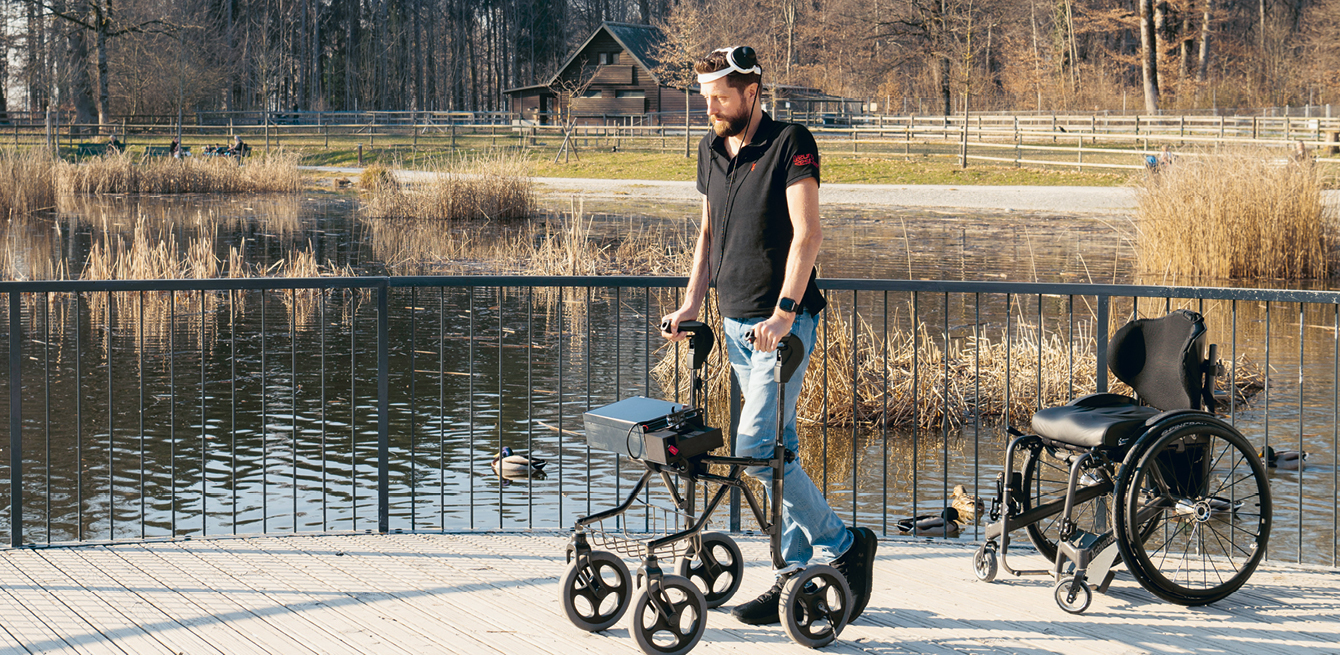
Artificial intelligence is making incredible breakthroughs in healthcare. The technology has now enabled a paraplegic patient to regain control of his legs.
Once again, and certainly not for the last time, Elon Musk is in the news. In December, the South African entrepreneur announced that his startup Neuralink would implant its first chip in a human brain within the next six months. What does it hope to do? Enhance the brain’s capabilities in a perfectly healthy individual.
The billionaire announced in July 2019 that Neuralink hoped to conduct its first human trials the following year. In the end, it had to wait until May 2023 for approval from the US Food and Drug Administration (FDA) to start testing Neuralink implants on people.
Closer to home, research is also advancing on ways to apply artificial intelligence to treatment. A team from the NeuroRestore research centre in Lausanne has recently developed a brain implant that has enabled a paralysed person to walk again using his thoughts, i.e. translating his intentions into movements.
This spectacular breakthrough was led by neurosurgeon Jocelyne Bloch from Lausanne University Hospital (CHUV) and neuroscientist Grégoire Courtine from École Polytechnique Fédérale de Lausanne (EPFL), a well-known duo in the field.
In 2018, as part of the Stimo project (see special report in IV No. 24), the multidisciplinary team restored the ability to walk in paraplegics by using electrical stimulation under the spinal cord injury. Now, another milestone has been reached, this time with the brain. The new system is comprised of both a spinal cord implant above the injury and another implant inserted in the cerebral cortex. “This implant decodes the patient’s movement intentions,” says project manager Henri Lorach. “The detected intention is converted into electrical impulses sent to the spinal cord, which triggers the desired movement. This restores the connection between the brain and spinal cord via a digital bridge” (see inset).
Developed in collaboration with the Clinatec research team at CEA Grenoble, the new device – BSI, for Brain-Spine Interface – has so far undergone only one clinical trial on a patient who had participated in the Stimo study. “This pilot study should be carried out on two patients, but so far we’ve only included one,” Jocelyne Bloch says. Further trials are planned to reactivate the upper limbs. The team has recently obtained authorisations from Swissmedic and swissethics, green-lighting the trial on the arms.
The devices could eventually be implanted in a single surgical procedure. As the patient in the trial already had a sensor implanted in his spinal cord, the team was able to decode the signals very quickly, and then train him to feel and imagine his movements. After about a week, and in less than 10 sessions, he was able to take his first steps.
The huge breakthrough compared with Stimo is that the brain implant gives him a smoother gait, even though he still walks more slowly than an able-bodied individual and requires assistance, such as crutches or a walker. “The patient’s brain triggers the movement, not an external programme,” Jocelyne Bloch explains. “It’s exactly the same mechanism as in an able-bodied person, except movement is not automatic.”
Neurosurgeon Jocelyne Bloch is not interested in the race to implant chips in people’s brains. “This unofficial competition is more fun than anything else. It’s good that lots of people are working in this area. It moves things forward.” Other institutions worldwide are also working on this type of research. The Clinatec centre in Grenoble has developed and uses the same cortical system as the CHUV-EPFL team, “except that the patient’s intentions control an exoskeleton that assists movements, whereas the goal of our project is to enable the patient to regain control over their own muscles,” Henri Lorach says.
For the time being, the technology developed is primarily intended to repair spinal cord injuries. “In theory, we could restore the circuit in other types of pathology, such as stroke cases, if cortical activity can still be recorded,” says Jocelyne Bloch.
And potentially, the system could also be used in people with Parkinson’s disease to improve their gait. /
The NeuroRestore implant is inserted above the brain’s surface underneath the skull bone. Measuring 5 centimetres in diameter, the device has 64 electrodes. Its role is to collect electrical signals from the motor cortex. A computer programme then detects signals involved in walking and decodes the limb joint movements.
A small computer is placed on the patient’s back. The patient’s intention, such as lifting the left foot to take a step, is sent to the computer using a special software programme, then to the stimulator located on the spinal cord injury, which delivers electrical stimulation to the region and generates the intended action.
Clearly seeing the actions to make requires training. That starts with a screen, by controlling a virtual avatar. And so it continues with each joint. In just one session, identifiable signals can be detected for four joints, e.g. left knee, right knee, left hip and right hip.
After one year of using the Brain-Spine Interface (BSI) regularly, the patient who participated in the clinical trial now walks with the assistance of a walker. “I can initiate movement with my brain. I can even talk while performing the movement. If I want to, I can hold a foot in the air before placing it back down. I can decide where I stop, take a bigger step than the other, and I can continue like that as long as I want.”
“I can initiate movement with my brain,” the patient explains after regaining his ability to walk with a brain implant.